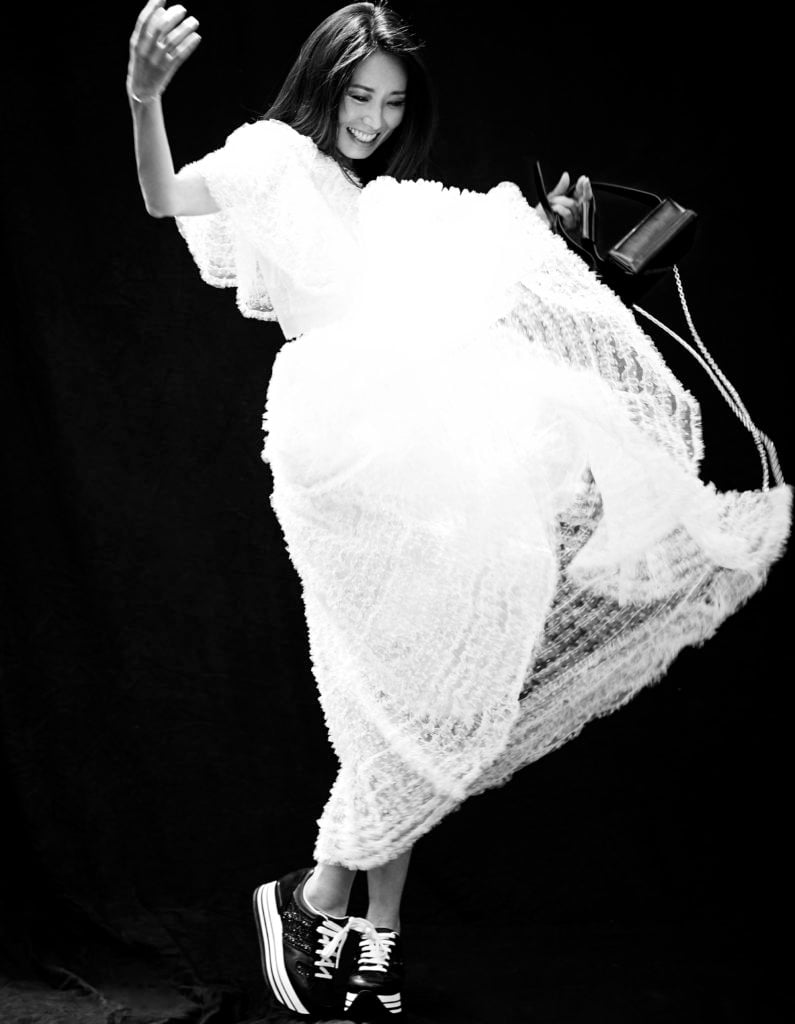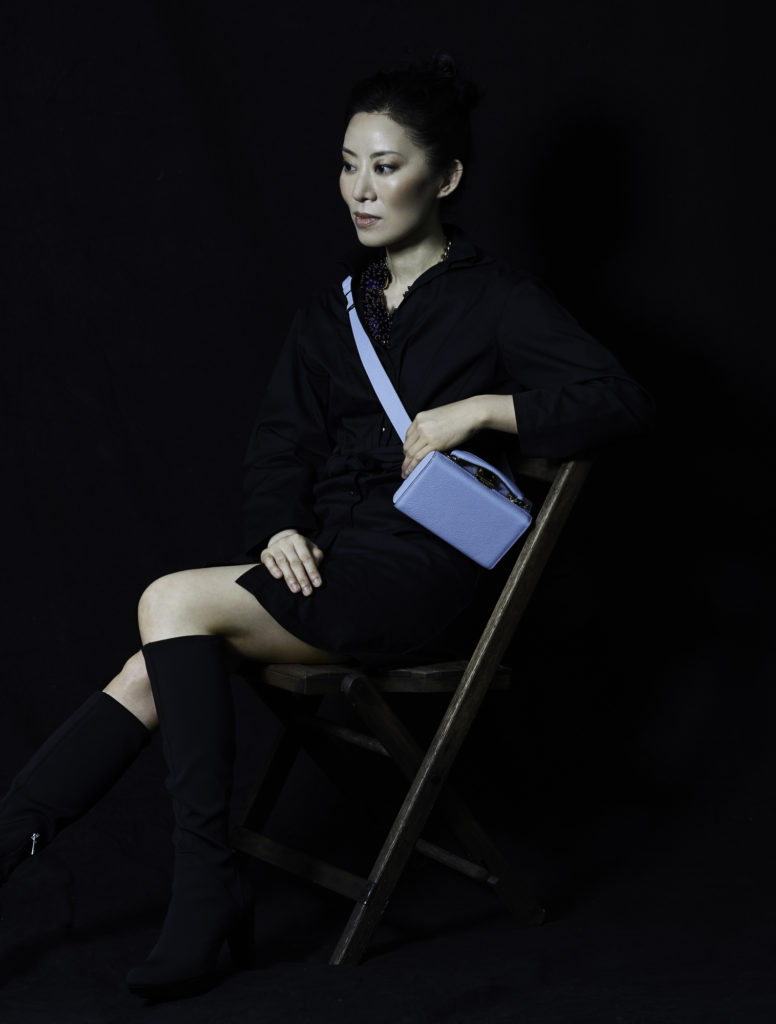From One Woman to Another
‘Be Ready to Be a Warrior’: Dealer Kate Shin and Artist Sun K. Kwak on Carving Out Their Place in the Art World
In part four of our “From One Woman to Another” series, Shin and Kwak explain why money isn’t everything.

In part four of our “From One Woman to Another” series, Shin and Kwak explain why money isn’t everything.

In Partnership With Mark Cross

“From One Woman to Another,” a five-part series co-produced by artnet News and Mark Cross, features intimate, candid conversations between eminent women at the pinnacle of the art industry and a mentor or protégé of their choosing, paired with original photography by David Lipman.
In the fourth installment of the series, artnet News contributor Maria Vogel interviewed art dealer Kate Shin and her protégé, the artist Sun K. Kwak.
The relationship between Kate Shin and the Korean artist Sun K. Kwak—who is best known for her “Space Drawing” installations made from black masking tape—exists on many planes, but it is grounded in a shared sense of spirituality.
When Shin, a former finance guru and real estate developer, undertook renovations of the Waterfall Mansion, a luxurious art gallery and private-events venue on New York’s Upper East Side, she felt it was necessary to involve artists in meaningful, long-term ways. After launching an artist residency program as part of the project, she developed an especially close relationship with Kwak, and the two bonded over their similar outlooks on life.
We sat down with Shin and Kwak to discuss how they each fell into the art world, the nature of their friendship, and how they find inspiration for their creative lives.
Tell me a bit about your backgrounds.
Kate Shin: When I was a little girl, I was an opera singer. I was always drawn to music, but I didn’t know how to switch the artistry on and off. Being fully emotional and exercising my feelings all the way—that’s what I was drawn to, perhaps overly so. I struggled with being practical and focusing on things like getting my homework done on time. Eventually, I learned that always freely expressing my emotions and feelings wasn’t something I should do, because it prohibited me from getting things done. And when I entered a pre-Julliard junior high school, everyone was so competitive.
That was my first interaction with the creative arts. I think I was born to be sensitive to something intangible. From there, I went into the finance world for a while. It was something I felt I could be practical, strong, and successful in.
Now, through the Waterfall Mansion, I’ve been able to reconnect with art. After beginning to speak with artists, I felt a sense of belonging. I truly fell in love with art when I connected my heart to the hearts of artists. Their emotions and my feelings are connected. I love seeing the process of how they break through, how they mature, and how they fall down. It’s almost like I’m a mother or teacher looking at their art.
Sun K. Kwak: I have a similar childhood background to Kate’s. My mom’s dream was for me to be a pianist. I started playing at age three, and I enjoyed it. That lasted until I was 13. But ever since I was a child, I also had a passion for drawing and painting.
Before entering college, and without permission from my parents, I went and met a teacher at a painting atelier. After that, I persuaded my parents to let me continue with my art education. It was difficult at first, because they had invested so much into my music career. After I entered college, I was happy to be able to focus on my painting all the time. I was always either in my studio or in the library reading artists’ books. I came to the United States in 1993 to continue my career, which created more conflict with my parents.
And when did you meet each other?
Shin: We first met in 2012 or 2013 after I opened the Waterfall Mansion for the first time. I hadn’t even decided at that point to keep the space for myself. My intent was to invest in it and sell it.
When Sun first met me, she probably thought of me as someone who only thinks about money. We met again a couple years later, at a Korean art gala, where we were seated at the same table. In this setting, I think Sun was able to see me differently, and we were able to talk more casually.
After first approaching her to be in an exhibition, it took a few years before the timing worked out. It was never about me bringing her work to Waterfall Mansion just to show it. It was about beginning the whole process of getting to know the work that I was going to be bringing into the space. Getting to know Sun confirmed a lot of the feelings I had about my intuition. The transparency and honesty with which I deal with artists, I think, helped Sun to open her own heart. Sun needs to feel a spiritual confirmation to show her work, which I also share. There was a natural fit.
Kwak: Yes, it’s not easy for me to open my mind right away, because, with my work, I’m not following economic opportunity. I would rather see the value of the person and decide for myself if it’s worth it to work together. Once I trust them, it’s a lifetime relationship and friendship. I didn’t want to rush it, which is why it was many years after meeting that we first worked together. Kate didn’t push me.
When I started to trust Kate, I started to witness the care that she puts into everything: her plants, her animals, her art. I began to open my mind to her true value and sincerity, which translates into how she handles artwork. From the moment it is being installed onward, Kate lives with the work. When I saw that, that was the confirmation I needed to know I could trust this person and work together.
You have both taken nontraditional strides in your careers. Do you feel that this commonality contributed to your understanding of one another?
Shin: Sure. We have a very similar perspective in that we seek values that cannot always be tangible or seen. We share an intuitive personality, one in which we don’t have to explain ourselves. We never have disputes, because we seek the same outcomes—which I think is rare. It’s not something you can learn; you just have to be likeminded.

Sun K. Kwak. Photo by David Lipman.
Who or what inspires you?
Shin: I love seeing artists transform the mindset of scarcity into abundance. It’s not that we have everything. But I tell them, “Let’s assume we have all the resources you need. How would you do this?” And they just fly.
When I see that, the work comes right away. That motivates and inspires me. I invest in someone else’s life; it’s not really about art. My job is to provide the platform that allows them to communicate their stories, and to help them turn their creativity into some kind of language that does not get lost in translation.
Kwak: Because I went against my parents’ will when I came to the US, I had to find a strong reason why this was what I was meant to be doing. When I was asked to create a large-scale installation at the Queens Museum, I began asking myself: What’s my value? What’s the value of my art? What’s my role in society? Somehow during the exhibition, I got all the answers I needed. It became obvious to me what art could give to society. It is something that you cannot buy with money. I never questioned myself after that.
What advice would you give young women who are hoping to have careers in the art industry?
Shin: When most people work with living artists, they try to quantify their lives, which diminishes the potential that those artists have. There should be a greater focus on investing in the process and journey of an artist. It’s okay to move slowly—art needs to be slow. You are dealing with real life. In this world, everything is transactional, everything is about results, everything is about what’s next. We often neglect the importance of process, and that kills art.
Kwak: When a younger artist approaches me and asks me this question, I tell them to reflect themselves in their work. It might seem cool to be an artist, but the reality is not always friendly, so I tell them to find their true motivation, what drives them, their passions. You have to really examine and test yourself in every way to make sure you truly love this and have a reason to go on this journey. You have to be ready to be a warrior—to have a love for art on the one hand, but to be a warrior and fight for it on the other. Most younger artists are scared when they hear this, but I tell them that if it’s your true passion, it’s a blessing, because it can be a blessing for others as well.
What are you both working on now?
Shin: I’ve started the Waterfall Arts Foundation, which is focused on encouraging artists across all disciplines to work together. I want to use creative capital to have artists from different fields collaborate and help each other. The art world is so categorized, but when you focus on the human aspect of creativity, there is so much more potential to be unlocked, and you can bring that creative power together.
Sun has been doing “Space Drawings” using masking tape, where she spends days getting to know a space. But the installation gets demolished after a show, and a lot of people wanted a way to collect Sun’s work. A collector suggested that she start translating the masking-tape works into paintings. Instead of going bigger, we are now going smaller. Waterfall is like that for me. I was once used to working with hundreds of people, and now I’m here doing all the work myself. It’s where I feel I’ve found myself.
Kwak: This wasn’t the first time I was asked to make something like this, but it was the first time I began to think of the “Space Drawings” in different ways, using different material. This is the beginning of a new moment for me. I’m not sure how many two-dimensional works and canvases I’ll create, but as long as it inspires me, I’ll continue.
What changes do you hope to see in the art industry 10 to 15 years from now?
Shin: As an analyst, I always look for benchmarks and statistics. When I first started Waterfall Mansion, I realized that most galleries do not have a sustainable model. Galleries are closing almost every day. In 10 years, something has to change—and I think it’s already changing.
Everything seems confused and lost in the art world, which affects the artists as well. We need to find sustainability for the middle-market galleries that are finding the artists of the future. But when galleries do not have their own clear vision and focus, there is no hope. That’s sad because it will affect the creative output of artists. For this reason, I’m always thinking about how we can monetize the value of living artists beyond just selling their work. It’s a very important question. It’s a paradigm shift that I’m starting, and hopefully in 10 years, it will have grown.
Kwak: I’ve always gone my own way and not thought about how the art world should be shaped. But in today’s world, the market doesn’t make things easy for artists, and that needs to change. My role is to continue to be a true artist—and true to myself.